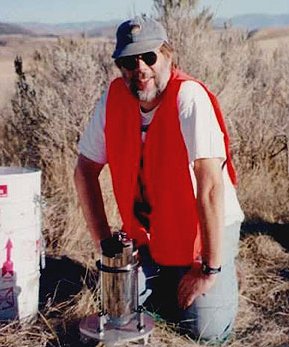Dr. Joseph Kruger

General Information
- Dr. Joseph M. Kruger
- Position: Associate Professor and Chair
- E-mail: krugerjm@lamar.edu
- Phone: (409) 880-8233
- Office: Geology Rm 113C
Education
- Ph.D. Geophysics, University of Arizona, Tucson, Ariz., 1991
- M.S. Geophysics, University of Texas at El Paso, 1983
- B.S. Geology/Physics, Appalachian State University, Boone, N.C., 1980
University, Professional and Community Service
- Expert source for the news media on geophysically related stories
- Rock and mineral presentations at local elementary schools and high school recruiter for Earth and Space Sciences at Lamar University
- Chair of the Arts and Sciences Faculty Council, Lamar University
- Administrator of the Earth and Space Sciences departmental computer lab.
- Departmental Library liaison at Lamar University
- Advised 1 undergraduate research assistant, Lamar University, 2006-2007
- Primary adviser to 3 graduate students, co-advisor to 1 graduate, Idaho State University, 1998-2004
- Guest speaker on earthquakes; Idaho Public Television's series called Dialogue With Kids, 2004
- Promotion and Tenure Committee, College of Arts and Sciences, Idaho State University, 2000-2001
- IRIS Board of Directors representative for Idaho State University, 2000-2004, and currently representative for Lamar University
- Council for Teaching and Learning, Idaho State University, 1999-2002
- Campus GIS Center Oversight Committee, Idaho State University, 1998-2003
- Organizational Committee, 35th Symposium on Engineering Geology and Geotechnical Engineering, 1999-2000
- Organizational Committee, Geological Society of America Rocky Mountain Section, 1999 Annual Meeting
- Search Committees for GIS Center Director and Remote Sensing Faculty, Idaho State University, 1997, 2000
- Reviewer of manuscripts, proposals, abstracts, 1995-present
Selected Publications
Kruger, J. M., and J. L. Jordan, 2007, Determination of Lunar Regolith Thickness and Exploration for Frozen Lunar Water Using Human-Operated Ground-Penetrating Radar [white paper]: Workshop on Science Associated with the Lunar Exploration Architecture, Tempe, Arizona, www.infonetic.com/tis/lea/WhitePapers.aspx?currentPage=White%20Papers
Kruger, J. M., T. J. Crane, A. D. Pope, M. E. Perkins, and P. K. Link, 2003, Structural and stratigraphic development of Neogene basins in the Marsh Valley, Lava Hot Springs, and Wakley Peak areas, southeast Idaho: Two phases of extension, in Raynolds, R. G., and Flores, R. M., eds., Cenozoic systems of the Rocky Mountain region: Rocky Mountain Society for Sedimentary Geology (SEPM), p. 407-457.
Kruger, J. M., A. C. Smith, and J. A. Welhan, 2002, Microgravity and magnetic detection of mafic dikes, fissures, and lava tubes in basalt: potential barriers and fast-flow paths for contaminant migration within the eastern Snake River Plain, Idaho [extended abstract]: Society of Exploration Geophysicists Annual meeting Expanded Technical Program Abstracts with Biographies, 2002, v. 72, p. 1440-1443.
Kruger, J. M., and R. A. Johnson, 2001, From Transition Zone to core complex: Deep reflection seismic imaging of the Basin and Range, southeast Arizona, in Erskine, M. C, Faulds, J. E., Bartley, J. M., and Rowley, P. D., eds., The geologic transition, high plateaus to Great Basin - A symposium and field guide (The Mackin Volume), : Utah Geological Association, Publication no. 30, p. 313-336.
Watney, W. L., J. M. Kruger, J. C. Davis, J. Harff, R. A. Olea, and G. C. Bohling, 1999, Validation of sediment accumulation regions in Kansas, USA, in Harff, J., Lemke, W., and Stattegger, K., eds., Computerized Modeling of Sedimentary Systems, Springer-Verlag, Berlin, Heidelberg, New York, p. 341-360.
Martinez, A., J. M. Kruger, and E. K. Franseen, 1998, Utility of ground-penetrating radar in near-surface, high-resolution imaging of Lansing-Kansas City (Pennsylvanian) limestone reservoir analogs: Kansas Geological Survey, Current Research in Earth Sciences, Bull. 241, part 3, www.kgs.ku.edu/Current/1998/martinez/martinez1.html
Kruger, J. M., J. E. Faulds, S. J. Reynolds, and D. A. Okaya, 1998, Seismic reflection evidence for detachment polarity beneath a major accommodation zone, west-central Arizona, in Faulds, J. E., and J. Stewart eds., Accommodation zones and transfer zones: The regional segmentation of the Basin and Range province: Geological Society of America, Special Paper 323, p. 89-113.
Kruger, J. M., 1998, High-resolution seismic survey of the Minneola Complex, southwest Kansas: Kansas Geological Survey Open-File Report OFR 98-44, 101 p., www.kgs.ku.edu/PRS/publication/OFR98_44/f2index.html
Kruger, J. M., A. Martinez, and P. Berendsen, 1997, Use of high-resolution ground-penetrating radar in kimberlite delineation: Mining Engineering, v. 49, p. 73-79.
Kruger, J. M., 1996, On-line gravity and magnetic maps of Kansas: Kansas Geological Survey, Open File Report 96-51, www.kgs.ku.edu/PRS/PotenFld/potential.html
Kruger, J. M., 1996, Seismic modeling in the Minneola complex, Ford and Clark Counties, Kansas: Differentiating thin-bedded Morrow sandstones from shale in lower Pennsylvanian channel fill: Kansas Geological Survey, Open File Report 96-50, www.kgs.ku.edu/PRS/publication/OFR96_50/index.html
Kruger, J. M., R. A. Johnson, and B. B. Houser, 1995, Miocene-Pliocene half-graben evolution, detachment faulting and late stage core complex uplift from reflection seismic data in southeast Arizona: Basin Research, v. 7, p. 129-149.
Kruger, J. M., and R. A. Johnson, 1994, Raft model of crustal extension: Evidence from seismic reflection data in southeast Arizona: Geology, v. 22, p. 351-354.
Keller, G. R., J. M. Kruger, K. J. Smith and W. M. Voight, 1990, The Ouachita System: A geophysical overview, in Hatcher, R. D., Jr., W. A. Thomas, and G. W. Viele, eds., The Appalachian-Ouachita Orogen in the United States: Boulder, Colorado, Geological Society of America, The Geology of North America, v. F-2, p. 689-694.
Kruger, J. M., and G. R. Keller, 1986, Interpretation of crustal structure from regional gravity anomalies, Ouachita Mountains area and adjacent Gulf Coastal Plain: American Association of Petroleum Geologists Bulletin, v. 70, p. 667-689.